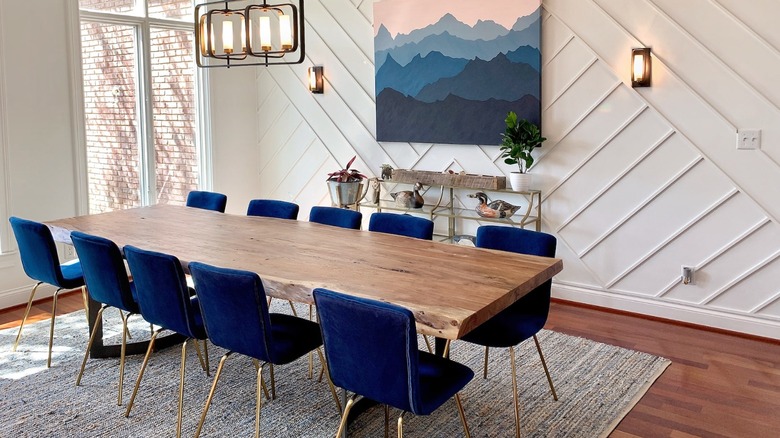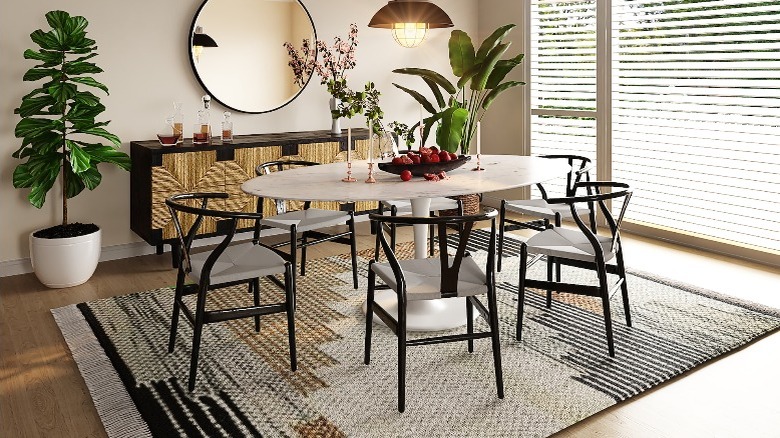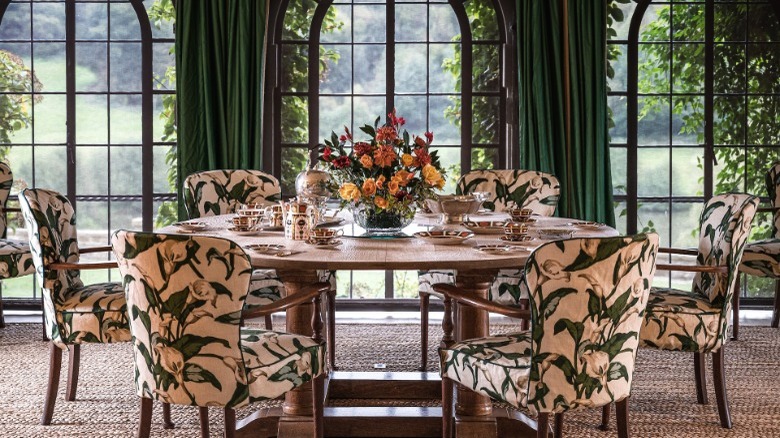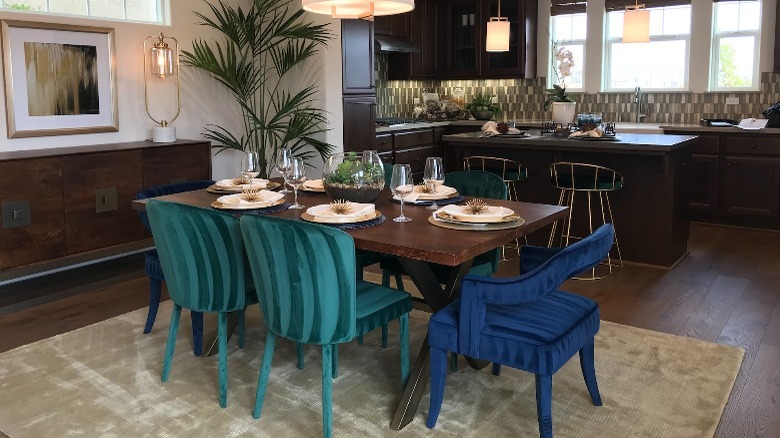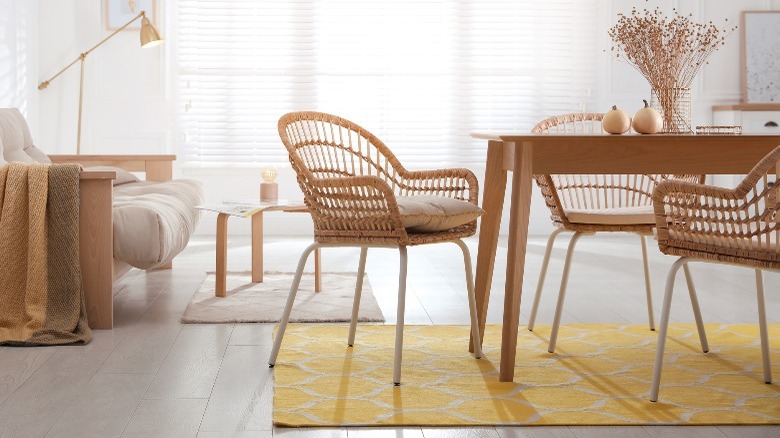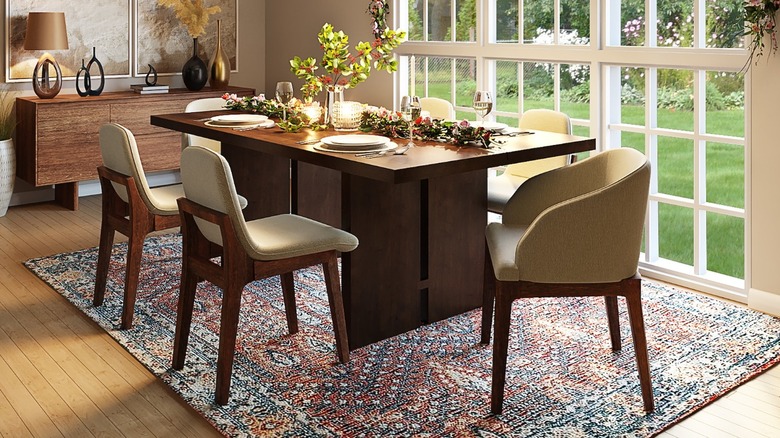5 Tips For Choosing A Beautiful Dining Room Rug
Whether your dining room is used often or rarely, no doubt you want it to be a beacon of warmth, style, and hospitality. Regardless of the aesthetic, every dining space needs an amply sized table for festive gatherings, chairs comfortable enough to linger, and plenty of storage. Although it's not a requirement, a beautiful area rug is a major plus. One can add color, texture, pattern, and softness to counter the hard surfaces and solid expanses of wood usually found there. Additionally, a rug provides some absorption of sound, lessening the noise from scraping forks and neighborhood traffic, so the food and company are more in focus.
While we know an area rug to be a stellar accompaniment to décor, and even a statement focal point, choosing one feels daunting. Rugs can be expensive and a tad perplexing regarding manufacturing techniques and materials. Not to mention there is an amount of pressure to pick the one that best complements the space's color, layout, and design scheme. Finally, there's a concern about how it will perform in a room whose purpose surrounds serving meals, which can be stained, messy, and sticky. However, according to Rug & Home, these floor coverings protect your floors from stains and scratches. We're here to offer a menu of tips for your dining room rug selection — like how to choose the right size and shape for your table — and we've included advice from a roster of experts. Let's dig in.
1. Choose the right size
One of the biggest mistakes when choosing a rug for the dining room is not selecting the correct size. Per Rug & Home, if it's too big, it will conceal a significant portion of the floor, with an appearance more like wall-to-wall carpeting rather than the desired framing effect of an area rug. For that reason, Insider recommends leaving 18 inches of the floor exposed around the rug, while HGTV says a 12-inch border is satisfactory. Furthermore, rugs covering walkways and high-traffic patterns can show wear and tear. On the other hand, an undersized rug negates many of its design and functional benefits. A larger rug contributes to the illusion of a larger space, whereas a too-small rug will feel underwhelming and seem like it was purchased to cut financial corners. Furthermore, it's unsafe and impractical when chair legs are caught on carpet edges.
A perfectly sized rug falls somewhere in between. Rug & Home suggests exceeding table dimensions by approximately 4 feet each in length and width — enough room to allow about 24 inches for chairs to pull away from the table on all sides. They note that it's essential to include extension leaves in your calculations to ensure the rug will accommodate the table when fully opened. However, the furnishings and home décor retailer explains that storage pieces, such as a buffet or china cabinet, should ideally be entirely off the rug.
2. Pick the perfect style
Not long ago, by conventional wisdom, we would have chosen a rug style that matched the furnishings. Now, however, the eclectic décor is gaining momentum, focusing on combining pieces that complement or contrast with one another to create personal and considered spaces. Per interior designer Chris Carroll of TLC Interiors, dining table and chair sets should be a thing left in the past. Instead, the designer recommends mixing materials, styles, and colors for a fresh and current look.
Certain area rugs will always be classic, including traditional woven and knotted options with rich colors, ornate patterns, and natural plant fibers like sisal and jute. These easily elevate a room and work across diverse aesthetics. For example, a highly embellished and bold carpet can play host to minimal and clean-lined neutral upholstery. Conversely, sisal is a simple textural ground for patterned chairs or a decorative table base. Real Simple notes that if you have a patterned rug that's visually too small for the room, it can be layered on top of a neutral foundation; just make sure it's not a trip hazard. Finally, animal prints are a surprisingly timeless option that can impart abundant texture and organic patterns in updated subdued palettes. A calming space will call for a different rug than one meant to have loads of energy; decide on the desired feel for your dining room before shopping.
3. Choose the material
According to Real Simple, a rug's material is its most significant characteristic. They categorize rugs this way: Natural fibers, including wool, silk, jute, hide, and sheepskin, and synthetic materials comprising faux hide, faux fur, and variations of polyester, nylon, and polypropylene. There are advantages and downsides to each; to that end, Ballard Designs recommends that you consider both the degree of use and your lifestyle. Wool rugs are generally high quality and crafted with traditional hand knotting and weaving techniques, though some options are machine woven. "Wool is my material of choice," interior designer Liz Toombs told Real Simple. "It holds color beautifully and cleans up easily, and my favorite feature is how soft wool feels. The cost can be higher than other materials, but it is worth it for the repellency."
Doris Leslie Blau rug gallery explains that wool is sustainable and entirely biodegradable, as well as resistant to abrasion and non-flammable. They note silk rugs are a luxurious choice, with lustrous pile and soft texture. Yet they take a copious amount of material, skilled artisans, and specialized machinery, which can be costly. However, their durability and appearance make them worth considering if the budget allows it. Lastly, while jute and bamboo offer great texture, Real Simple cautions they can be hard to keep clean. Regarding synthetics, Toombs told Real Simple, "The main selling feature is the price point; they are very budget-friendly, making it affordable to swap out rugs often." Furthermore, many are easy to maintain and fade-resistant.
4. Decide on the color
A rug dramatically impacts the mood created in the dining room. Would you prefer a relaxing neutral space, or do you have an appetite for pumped-up color? Perhaps, a monochromatic room is a way to satisfy both cravings. Imagine sky-blue walls, upholstered chairs, and a rug in shades to match, like in this gorgeous dining room by Kathy Kuo Home. Per Slow Living LDN, a monochromatic palette utilizes various tints of the same hue, and the result is calming without being colorless. Similarly, one can introduce a color close to, but not within, the same family. Above, a cheery yellow flat-weave carpet adds vitality to the neutral scheme. Yet because it's light like the rest of the décor and flooring and contains a warm undertone, as does the wood furniture, the overall effect is soothing and cozy.
On the other hand, contrast and bold pattern will have the opposite outcome, fashioning a lively and energetic space. Additionally, Ballard Designs explains that a dark rug conveys an intimate, cocooning space, while a light one creates an illusion of openness. The wonderful thing about any of these approaches is they're not limited to one style. However, since the rug lends support to the star, the dining set, pay particular attention to how it affects the tones in your table and storage pieces.
5. Order a sample
Most people wouldn't buy a sofa before sitting on it, and we know how important it is to swatch paint before mixing up a five-gallon bucket of that hopefully perfect shade. So why would you purchase a rug without seeing a sample in your space? Unless buying a one-of-a-kind piece or forced to make an urgent decision, such as from an online auction or estate sale, it's far better to undertake the time and minimal expense to order and review rug swatches. Even when returns are allowed, a rug is an awkward and heavy item that can be costly to ship; if not otherwise specified in the return policy, you'll likely need to absorb the fee.
To put customers at ease, many rug purveyors now offer a sample service that is either free or low-cost; charges are usually applied to a subsequent rug purchase. Wendy Morris Designs encourages clients to try a miniature version of the item. According to the company's co-founder, Wendy Morris, "All colours vary considerably when viewed on the floor." She explains, "As different types of light fall from a number of directions, colours can change considerably. They also work differently when seen alongside other – particularly dominant – colours within a space, so it is really useful to be able to check how something will look in place." Morris adds that neutral rugs are just as essential to road-test as the undertones can be challenging to represent accurately through photographs.

